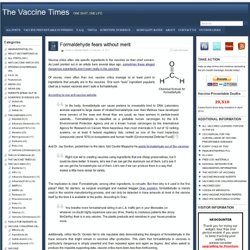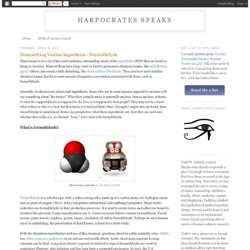

[Controversies with aspartame]. [Med Pregl. 2003. Www.atsdr.cdc.gov/toxprofiles/tp111.pdf. Formaldehyde fears without merit » The Vaccine Times. Chemical formula for formaldehyde Vaccine critics often cite specific ingredients in the vaccines as their chief concern.

As Leart pointed out in an article here several days ago, sometimes these alleged dangerous ingredients aren’t even really in the vaccines . Of course, more often than not, vaccine critics manage to at least point to ingredients that actually are in the vaccines. One such “toxic” ingredient popularly cited as a reason vaccines aren’t safe is formaldehyde. According to one anti-vaccine website : In the body, formaldehyde can cause proteins to irreversibly bind to DNA. And Dr. Right now we’re creating vaccines using ingredients that are cheap preservatives, but it could be done better.
Formaldehyde (CASRN 50-00-0) You will need Adobe Reader to view some of the files on this page.

See EPA's PDF page to learn more. Formaldehyde; CASRN 50-00-0 Human health assessment information on a chemical substance is included in the IRIS database only after a comprehensive review of toxicity data, as outlined in the IRIS assessment development process . Sections I (Health Hazard Assessments for Noncarcinogenic Effects) and II (Carcinogenicity Assessment for Lifetime Exposure) present the conclusions that were reached during the assessment development process. Supporting information and explanations of the methods used to derive the values given in IRIS are provided in the guidance documents located on the IRIS website . STATUS OF DATA FOR Formaldehyde File First On-Line 10/01/1989 _I.
_I.A. Substance Name — Formaldehyde CASRN — 50-00-0 Last Revised — 09/01/1990 The oral Reference Dose (RfD) is based on the assumption that thresholds exist for certain toxic effects such as cellular necrosis. Harpocrates Speaks: Demystifying Vaccine Ingredients - Formaldehyde. There seems to be a lot of fear and confusion surrounding many of the ingredients (PDF) that are listed as being in vaccines.

Many of them have long, scary or hard to pronounce chemical names, like polyethylene glycol . Others just sound a little disturbing, like chick embryo fibroblasts . Then you have more familiar chemical names that have some manner of negative connotation associated with them, such as formaldehyde. Www.dorway.com/gross.txt. Rat Study Shows Cancer, Aspartame Link. But Critics Charge That Research Is Flawed Why do I need to register or sign in for WebMD to save?

We will provide you with a dropdown of all your saved articles when you are registered and signed in. Nov. 18, 2005 - A study in rats links the popular artificial sweetener aspartame to a wide range of cancers, but industry officials charge that the research is badly flawed. Use of aspartame in pregnancy. Int J Fertil. 1985;30(1):85-7.

Use of aspartame in pregnancy. Sturtevant FM. The low-calorie sweetening agent, aspartame, is broken down in the small intestine into three moieties: aspartic acid, methanol and phenylalanine. FDA Pivotal Safety Study: Aspartame Caused Brain Seizures. Email this article to a friend by Pete Hardin "Despite approval by the federal Food and Drug Administration as a sweetener, Aspartame remains the focus of serious human health questions poised by a core of skeptics.
Aspartame is the generic name for "NutraSweet", which is owned by Monsanto Corp. FDA okayed Aspartame for limited food use in the early l980s. In June 1996, FDA sanctioned use of Aspartame in thousands of food products. FDA's human "safety" determination for Aspartame is based upon some 112 studies submitted to FDA by the original manufacturer, Searle Pharmaceuticals. Critics have been relooking those "pivotal" studies and come away puzzled how FDA can deduce human "safety". The monkeys were divided in three groups: a low dose group (1.0 g/kg), a medium dose group (3.0 g/kg.) and a high dose group (4-6 g/kg). There was no control group. All medium and high dose monkeys showed increased phenylalanine levels in their blood. Data for the deceased monkey were lost.